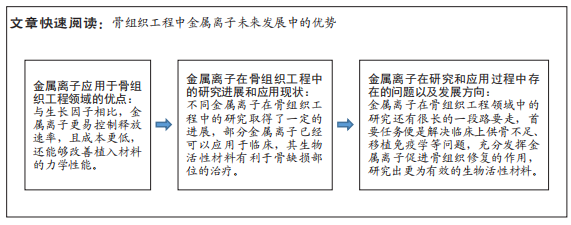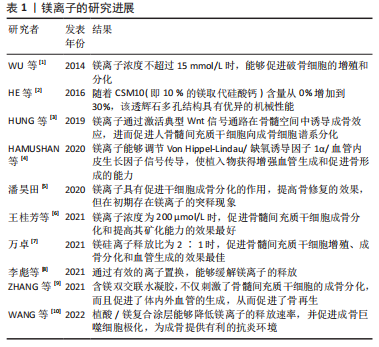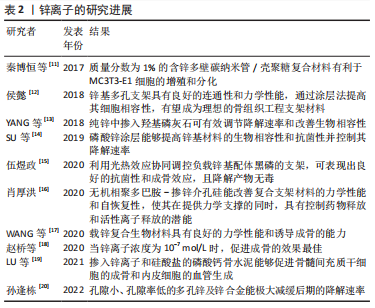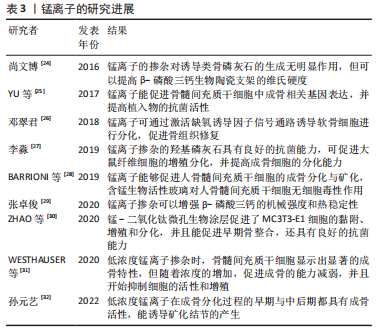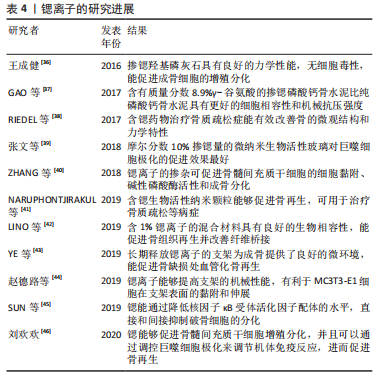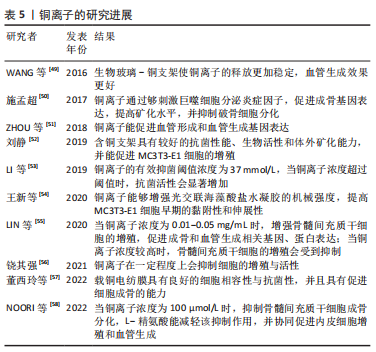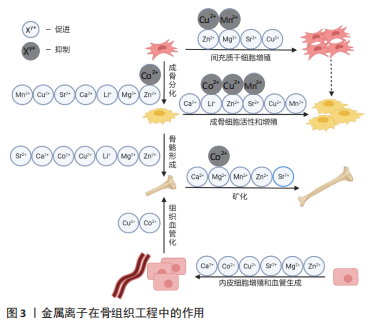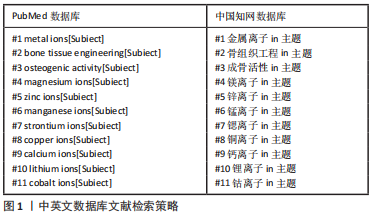[1] WU L, LUTHRINGER BJ, FEYERABEND F, et al. Effects of extracellular magnesium on the differentiation and function of human osteoclasts. Acta Biomater. 2014;10(6):2843-2854.
[2] HE D, ZHUANG C, XU S, et al. 3D printing of Mg-substituted wollastonite reinforcing diopside porous bioceramics with enhanced mechanical and biological performances. Bioact Mater. 2016;1(1):85-92.
[3] HUNG CC, CHAYA A, LIU K, et al. The role of magnesium ions in bone regeneration involves the canonical Wnt signaling pathway. Acta Biomater. 2019;98:246-255.
[4] HAMUSHAN M, CAI W, ZHANG Y, et al. High-purity magnesium pin enhances bone consolidation in distraction osteogenesis model through activation of the VHL/HIF-1α/VEGF signaling. J Biomater Appl. 2020;35(2):224-236.
[5] 潘昊田.负载Mg元素的GelMA大孔水凝胶支架构建及其骨组织工程的应用研究[D].广州:华南理工大学,2020.
[6] 王桂芳,吕凯歌.镁离子激活自噬促进大鼠骨髓间充质干细胞成骨分化的体外实验观察[J].口腔颌面外科杂志,2021,31(4):212-220.
[7] 万卓.镁硅离子共释放可注射微球促成骨成血管协同效应的研究[D].北京:北京化工大学,2021.
[8] 李彪,李齐宏,胡先同,等.含镁脱细胞牛骨基质的制备与性能评估[J].军事医学, 2021,45(1):40-44+49.
[9] ZHANG X, HUANG P, JIANG G, et al. A novel magnesium ion-incorporating dual-crosslinked hydrogel to improve bone scaffold-mediated osteogenesis and angiogenesis. Mater Sci Eng C Mater Biol Appl. 2021;121:111868.
[10] WANG F, SUN P, XIE E, et al. Phytic acid/magnesium ion complex coating on PEEK fiber woven fabric as an artificial ligament with anti-fibrogenesis and osteogenesis for ligament-bone healing. Biomater Adv. 2022;140:213079.
[11] 秦博恒,杨犇,何东宁.载锌多壁碳纳米管/壳聚糖复合材料成骨性能的研究[J].口腔医学研究,2017,33(7):725-728.
[12] 侯懿.骨组织工程用锌基多孔支架及其表面生物活性涂层的制备与表征[D].上海:上海交通大学,2018.
[13] YANG H, QU X, LIN W, et al. In vitro and in vivo studies on zinc-hydroxyapatite composites as novel biodegradable metal matrix composite for orthopedic applications. Acta Biomater. 2018;71:200-214.
[14] SU Y, WANG K, GAO J, et al. Enhanced cytocompatibility and antibacterial property of zinc phosphate coating on biodegradable zinc materials. Acta Biomater. 2019;98:174-185.
[15] 伍煜政.锌基配体黑磷修饰骨组织工程支架及其光热抗菌与促成骨性能研究[D].北京:中国科学院大学,2020.
[16] 肖厚洪.离子掺杂介孔硅改性水凝胶材料的研究及其性能表征[D].广州:暨南大学,2020.
[17] WANG C, LIU J, LIU Y, et al. Study on osteogenesis of zinc-loaded carbon nanotubes/chitosan composite biomaterials in rat skull defects. J Mater Sci Mater Med. 2020; 31(2):15.
[18] 赵桥,杨飞,张成栋,等.锌离子浓度可影响兔骨髓间充质干细胞的增殖与成骨分化[J].中国组织工程研究,2020,24(19):2985-2990.
[19] LU T, ZHANG J, YUAN X, et al. Enhanced osteogenesis and angiogenesis of calcium phosphate cement incorporated with zinc silicate by synergy effect of zinc and silicon ions. Mater Sci Eng C Mater Biol Appl. 2021;131:112490.
[20] 孙逢栋.锌基多孔骨组织工程支架的制备与表征[D].天津:天津理工大学, 2022.
[21] RAZAVI M, HUANG Y. Assessment of magnesium-based biomaterials:from bench to clinic. Biomater Sci. 2019;7(6):2241-2263.
[22] BEKMURZAYEVA A, DUNCANSON WJ, AZEVEDO HS, et al. Surface modification of stainless steel for biomedical applications:Revisiting a century-old material. Mater Sci Eng C Mater Biol Appl. 2018;93:1073-1089.
[23] KIRADZHIYSKA DD, MANTCHEVA RD. Overview of Biocompatible Materials and Their Use in Medicine. Folia Med (Plovdiv). 2019;61(1):34-40.
[24] 尚文博.锰掺杂β-磷酸三钙多孔仿骨材料性能研究[D].长春:吉林大学,2016.
[25] YU L, TIAN Y, QIAO Y, et al. Mn-containing titanium surface with favorable osteogenic and antimicrobial functions synthesized by PIII&D. Colloids Surf B Biointerfaces. 2017; 152:376-384.
[26] 邓翠君.骨-软骨复杂组织修复生物活性无机材料的制备及性能研究[D].上海:中国科学院上海硅酸盐研究所,2018.
[27] 李淼.微量元素掺杂羟基磷灰石的制备及生物学效应研究[D].上海:上海师范大学,2019.
[28] BARRIONI BR, NORRIS E, LI S, et al. Osteogenic potential of sol-gel bioactive glasses containing manganese. J Mater Sci Mater Med. 2019;30(7):86.
[29] 张卓俊.离子掺杂β-磷酸三钙材料制备及3D支架性能研究[D].哈尔滨:哈尔滨工业大学,2020.
[30] ZHAO QM, SUN YY, WU CS, et al. Enhanced osteogenic activity and antibacterial ability of manganese-titanium dioxide microporous coating on titanium surfaces. Nanotoxicology. 2020;14(3):289-309.
[31] WESTHAUSER F, WILKESMANN S, NAWAZ Q, et al. Osteogenic properties of manganese-doped mesoporous bioactive glass nanoparticles. J Biomed Mater Res A. 2020;108(9):1806-1815.
[32] 孙元艺.锰复合骨修复支架的3D打印及其性能评估[D].北京:中国科学院大学(中国科学院深圳先进技术研究院),2022.
[33] HREHA J, WEY A, CUNNINGHAM C, et al. Local manganese chloride treatment accelerates fracture healing in a rat model. J Orthop Res. 2015;33(1):122-130.
[34] LI L, YANG X. The Essential Element Manganese,Oxidative Stress,and Metabolic Diseases:Links and Interactions. Oxid Med Cell Longev. 2018;2018:7580707.
[35] 郭书含,宋平平,陈曾曾,等.人骨髓间充质干细胞脑内移植治疗锰中毒模型的可行性[J].中国组织工程研究,2018,22(9):1402-1406.
[36] 王成健.多孔SrO/HA生物复合陶瓷骨修复材料的制备及体外生物相容性研究[D].昆明:昆明理工大学,2016.
[37] GAO C, LIU H, LUO ZP, et al. Modification of calcium phosphate cement with poly(γ-glutamic acid)and its strontium salt for kyphoplasty application. Mater Sci Eng C Mater Biol Appl. 2017;80:352-361.
[38] RIEDEL C, ZIMMERMANN EA, ZUSTIN J, et al. The incorporation of fluoride and strontium in hydroxyapatite affects the composition,structure,and mechanical properties of human cortical bone. J Biomed Mater Res A. 2017;105(2):433-442.
[39] 张文,黄德球,郭周义,等.掺锶生物活性玻璃通过调控巨噬细胞极化促进成骨[J].激光生物学报,2018,27(3):232-239.
[40] ZHANG X, LI H, LIN C, et al. Synergetic topography and chemistry cues guiding osteogenic differentiation in bone marrow stromal cells through ERK1/2 and p38 MAPK signaling pathway. Biomater Sci. 2018;6(2):418-430.
[41] NARUPHONTJIRAKUL P, TSIGKOU O, LI S, et al. Human mesenchymal stem cells differentiate into an osteogenic lineage in presence of strontium containing bioactive glass nanoparticles. Acta Biomater. 2019;90:373-392.
[42] LINO AB, MCCARTHY AD, FERNÁNDEZ JM. Evaluation of Strontium-Containing PCL-PDIPF Scaffolds for Bone Tissue Engineering:In Vitro and In Vivo Studies. Ann Biomed Eng. 2019;47(3):902-912.
[43] YE H, ZHU J, DENG D, et al. Enhanced osteogenesis and angiogenesis by PCL/chitosan/Sr-doped calcium phosphate electrospun nanocomposite membrane for guided bone regeneration. J Biomater Sci Polym Ed. 2019;30(16):1505-1522.
[44] 赵德路,铁朝荣,王新,等.复合锶离子光交联海藻酸盐水凝胶支架的机械和生物学性能[J].中国组织工程研究,2019,23(18):2880-2887.
[45] SUN T, LI Z, ZHONG X, et al. Strontium inhibits osteoclastogenesis by enhancing LRP6 and β-catenin-mediated OPG targeted by miR-181d-5p. J Cell Commun Signal. 2019;13(1):85-97.
[46] 刘欢欢.基于胶原自组装/矿化协同策略制备掺杂生物活性元素的骨组织工程胶原支架[D].天津:天津医科大学,2020.
[47] SHI M, CHEN Z, FARNAGHI S, et al. Copper-doped mesoporous silica nanospheres,a promising immunomodulatory agent for inducing osteogenesis. Acta Biomater. 2016; 30:334-344.
[48] ALI A, ERSHAD M, VYAS VK, et al. Studies on effect of CuO addition on mechanical properties and in vitro cytocompatibility in 1393 bioactive glass scaffold. Mater Sci Eng C Mater Biol Appl. 2018;93:341-355.
[49] Wang H,Zhao S,Xiao W, et al.Influence of Cu doping in borosilicate bioactive glass and the properties of its derived scaffolds.Mater Sci Eng C Mater Biol Appl. 2016;58: 194-203.
[50] 施孟超.多功能介孔生物活性材料用于骨组织工程的研究[D].中国科学院大学, 2017.
[51] Zhou Y,Han S,Xiao L,et al.Accelerated host angiogenesis and immune responses by ion release from mesoporous bioactive glass.J Mater Chem B. 2018; 6(20):3274-3284.
[52] 刘静.基于超低温挤出沉积技术的含铜介孔生物活性玻璃/海藻酸钠复合骨组织工程支架的研究[D].武汉:华中科技大学,2019.
[53] LI K, XIA C, QIAO Y, et al. Dose-response relationships between copper and its biocompatibility/antibacterial activities. J Trace Elem Med Biol. 2019;55:127-135.
[54] 王新,铁朝荣,尹苗,等.铜离子光双交联海藻酸盐水凝胶支架材料的性能研究[J].临床口腔医学杂志,2020,36(2):84-88.
[55] LIN Z, CAO Y, ZOU J, et al. Improved osteogenesis and angiogenesis of a novel copper ions doped calcium phosphate cement. Mater Sci Eng C Mater Biol Appl. 2020;114: 111032.
[56] 铙其强.PDA负载金属离子修饰PCL/β-TCP支架表面用于骨组织工程[D].南昌:南昌大学,2021.
[57] 董西玲,惠敏,曹飞,等.聚多巴胺修饰聚己内酯电纺膜载铜涂层的制备及抗菌和细胞性能评价[J].中国组织工程研究,2022,26(27):4272-4278.
[58] NOORI A, HOSEINPOUR M, KOLIVAND S, et al. Synergy effects of copper and L-arginine on osteogenic,angiogenic,and antibacterial activities. Tissue Cell. 2022;77:101849.
[59] YANG Y, XIAO Y. Biomaterials Regulating Bone Hematoma for Osteogenesis. Adv Healthc Mater. 2020:e2000726. doi: 10.1002/adhm.202000726.
[60] 雷群,林东,黄文秀,等.钙离子对人成骨细胞迁移与成骨分化的影响[J].华西口腔医学杂志,2018,36(6):602-608.
[61] KUMAGAI H, MAKIHARA T, FUNAYAMA T, et al. Angiogenesis and new bone formation in novel unidirectional porous beta-tricalcium phosphate:a histological study. J Artif Organs. 2019;22(4):294-299.
[62] GARNER AL, FRELINGER AL 3RD, GERRITS AJ, et al. Using extracellular calcium concentration and electric pulse conditions to tune platelet-rich plasma growth factor release and clotting. Med Hypotheses. 2019;125:100-105.
[63] WANG X, ZHANG Y, JI W, et al. Categorising bone defect hematomas-Enhance early bone healing. Med Hypotheses. 2018;113:77-80.
[64] WANG L, ZHANG K, HAO Y, et al. Osteoblast/bone-tissue responses to porous surface of polyetheretherketone-nanoporous lithium-doped magnesium silicate blends’integration with polyetheretherketone. Int J Nanomedicine. 2019;14:4975-4989.
[65] 黄廷贲.掺锂种植体表面调控β-catenin/RANKL/OPG信号轴在种植体骨结合形成中的作用及机制[D].杭州:浙江大学,2019.
[66] 李俊刚.3D打印掺钴生物陶瓷支架介导成骨-成血管偶联促进骨修复的作用研究[D].福州:福建医科大学,2021.
[67] 蒋昇源,李丹,姜建浩,等.假体无菌性松动过程中Co2+对成骨前体细胞的生物学反应[J].中国组织工程研究,2021,25(21):3292-3299.
[68] 刘菲菲.金属纳米粒子增强的抗菌聚乳酸基复合纤维的构建及其性能研究[D].乌鲁木齐:新疆师范大学,2021.
[69] 刘香笈.一种Ba/Mg共掺杂羟基磷灰石的合成与其复合材料在骨修复中的研究[D].长春:吉林大学,2021.
[70] OKUZU Y, FUJIBAYASHI S, YAMAGUCHI S, et al. In vitro study of antibacterial and osteogenic activity of titanium metal releasing strontium and silver ions. J Biomater Appl. 2021;35(6):670-680.
[71] 陈思奇.掺杂Cu/Mg的硅酸钙生物陶瓷与纳米羟基磷灰石复合多孔支架对成骨影响[D].泸州:西南医科大学,2021.
[72] YEDEKÇI B, TEZCANER A, ALSHEMARY AZ, et al. Synthesis and sintering of B,Sr,Mg multi-doped hydroxyapatites:Structural,mechanical and biological characterization. J Mech Behav Biomed Mater. 2021;115:104230.
[73] 张畅.含锰镁合金的生物学活性及其成骨能力初探[D].遵义:遵义医科大学,2022.
[74] 任浩征.可降解Zn基多孔骨修复支架材料的制备与性能研究[D].天津:天津理工大学,2022. |
